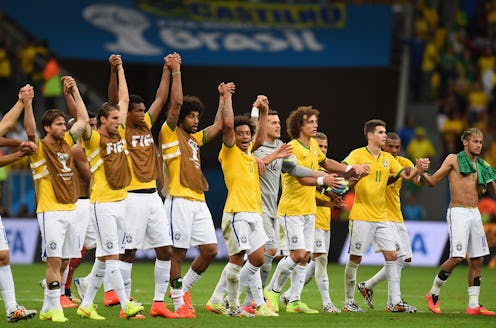News
Why Do Soccer Players Fake Injuries On The Field?
If you're one of the people who's been gritting your teeth watching the World Cup, thinking "God, those guys have been hitting the ground an awful lot," well, now you have some numbers on your side. Throughout the tournament's first 32 games, Brazil faked more injuries than any World Cup team. In short, they may be the best floppers of 2014, and whether a deliberate strategy or, let's say, an improvisational flair, it seems to be paying off.
First things first, defining the terms — "flopping" is when a player tries to trick a referee into thinking he's been fouled, interfered with, injured, whatever you please so long as it draws a reprimand on the nearest defender. Flopping is not, as it happens, exclusive to soccer or to international sports. NBA basketball is rife with players constantly angling to get foul calls where none took place. One player, say, sidles up to another, makes physical contact, then flails backwards as though hit by a sledgehammer. It happens all the time, but it's taken center stage at the World Cup in a way that American fans rarely have the chance to see.
There's a grim and grisly irony in this for Brazilian fans. During their victory against Colombia Friday, superstar striker Neymar went down with what was a very real, very debilitating injury — he fractured one of his vertebrae after being dislodged from the ground and knocked airborne, tragically ending his World Cup run. Neymar himself is one of Team Brazil's most beloved players, to be sure, but is also internationally scorned over his frequent, histrionic flopping.
Thanks to data recorded by The Wall Street Journal, the breadth of Team Brazil flopping now has some figures attached. The WSJ followed every instance in those first 32 games in which a player went to the ground, apparently racked with pain, only to spring up their feet again and keep going. Instances of apparently serious or sincere injuries which forced a man off the field weren't counted — there were only nine of them, however — leaving 293 such drops remaining.
Of those 293, Brazil led the pack through their first two games with 17 flops, and while that figure has surely changed in the meantime, regular World Cup viewers likely won't find much visual evidence anything's changed. So, here's the million-dollar question...
Why Do They Do It?
In simplest terms, the same reason any athlete fudges the rules here or there — to gain an advantage, and in the context of soccer, a big advantage indeed.
In the NBA, where flopping also tends to reign supreme, there's a considerably greater margin of error for teams in terms of fouling. While certain types of contact, specifically "unnecessary and excessive," can cause a flagrant foul to be called, every player can be charged with six run-of-the-mill fouls before being thrown out of the game.
In soccer, and indeed in World Cup play, the stakes run much higher for each individual player. That's because it takes only two yellow cards, referee-dispensed penalties for rough fouls, to boot a player from the match altogether. An especially vicious foul means a red card, and automatic expulsion.
Even further, successfully drawing a foul during a goal-scoring opportunity can net a player a free kick near the goal, and a prime position to score. Brazilian striker Fred achieved just this feat in his team's opening-round game against Croatia.
Like any sport that matters so much to so many people, players are always looking for that edge, morality and honesty notwithstanding. So the temptation to lean into a defender, to get tripped up and fall to the ground howling as though you've been shot — it's all perfectly understandable. You want to win the game, and it's easier to do that if your opponent's best players have to sit on the sideline. The New Yorker put out this wonderful, brief primer on different types of cheating in soccer, right around the start of the World Cup.
Flopping also allows winning teams to burn time off the clock, and while such interruptions are supposed to be recovered in stoppage time before the game's end — a process extremely open to controversy — that doesn't prevent a lagging team from halting things strategically to catch a second wind.
On this count, Brazil actually wasn't the worst. Despite leading the field in dropping to the ground, they got back up quicker than some of their competitors. Honduras and France, while they were still playing, were prime offenders in this regard — both ate up over seven minutes of playing time with faux-injuries.
